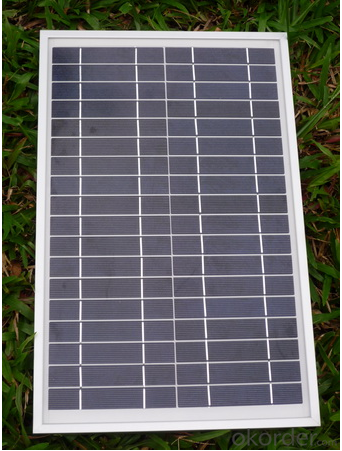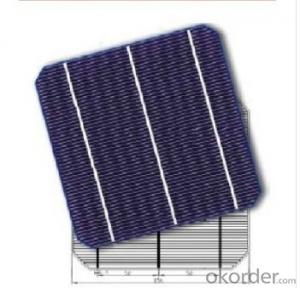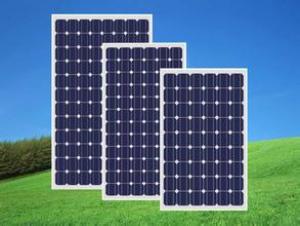250W Mono Solar Panel with High Efficient Output with 25 Years Quality Assurance
- Loading Port:
- Shanghai
- Payment Terms:
- TT or LC
- Min Order Qty:
- 1 PCS
- Supply Capability:
- 100000 PCS/month
OKorder Service Pledge
OKorder Financial Service
You Might Also Like
Mono Solar Cell 156mm
Product Description
Most solar modules are currently produced from crystalline silicon (c-Si) solar cells made of multicrystalline andmonocrystalline silicon. In 2013, crystalline silicon accounted for more than 90 percent of worldwide PV production, while the rest of the overall market is made up as they offer the highest ratio of generated power per kilogram lifted into space. MJ-cells are compound semiconductors and made of gallium arsenide (GaAs) and other semiconductor materials. Another emerging PV technology using MJ-cells is concentrator photovoltaics (CPV).

Feature
High quality cell
Level A cell
Dimensione:125*125mm Diagonal:150mm / 165mm
Qualified certification: TUV,CE certification.Warranty: five years for whole unit
Application Of Mono Solar Cell 156mm
Monocrystalline solar cells are currently the fastest developing a solar cell, its structure and production process has been finalized, the products have been widely used for space and ground. Such solar cells with high purity silicon rods as raw materials. Silicon rods, material performance indicators in order to reduce production costs, and now solar terrestrial applications such as the use of solar grade somewhat relaxed. Some semiconductor devices can also be used for processing materials and discard the head and tail of silicon materials, solar cells after re-drawn into a dedicated silicon rods.
Physical characteristic

- Q:Can solar cells be used in shopping malls?
- Yes, solar cells can definitely be used in shopping malls. They are a sustainable and environmentally-friendly source of energy that can be integrated into the mall's infrastructure to reduce electricity costs and carbon footprint.
- Q:How do solar cells perform in areas with frequent power outages?
- Solar cells can be a reliable source of electricity in areas with frequent power outages. Since solar cells generate electricity from sunlight, they are not dependent on the grid for power supply. This means that even during power outages, solar cells can continue to produce electricity as long as there is sufficient sunlight available. However, the performance of solar cells during cloudy or rainy days may be affected, resulting in reduced electricity generation. Additionally, to ensure uninterrupted power supply, it is advisable to use energy storage systems such as batteries in conjunction with solar cells in areas with frequent power outages.
- Q:What is a thin-film solar cell?
- A thin-film solar cell is a type of solar cell that is made by depositing one or more thin layers of photovoltaic material onto a substrate, such as glass or plastic. These cells are lightweight, flexible, and can be produced using less material, making them more cost-effective than traditional silicon-based solar cells. However, they typically have a lower efficiency compared to silicon-based cells.
- Q:Can solar cells be used for telecommunications infrastructure?
- Yes, solar cells can be used for telecommunications infrastructure. Solar cells can generate electricity from sunlight, making them an ideal renewable energy source for powering remote telecommunications towers, base stations, and other infrastructure. They can provide a reliable and sustainable power supply in areas where grid electricity is unavailable or unreliable, reducing dependence on fossil fuels and minimizing operational costs.
- Q:How do solar cells impact job creation?
- Solar cells impact job creation by creating a demand for skilled workers in the solar industry. As the adoption of solar energy grows, more jobs are created in manufacturing, installation, maintenance, and research and development of solar cells. This not only helps stimulate the economy but also provides employment opportunities for individuals in a rapidly expanding sector.
- Q:How do solar cells perform in polluted environments?
- Solar cells can still function effectively in polluted environments, although their performance may be slightly reduced. The presence of air pollution, such as smog or particulate matter, can block or scatter sunlight, resulting in a decrease in the amount of energy captured by the solar cells. Additionally, the accumulation of dust and dirt on the surface of the cells can further diminish their efficiency. Therefore, regular cleaning and maintenance are important to optimize the performance of solar cells in polluted environments.
- Q:What is the impact of temperature fluctuations on solar cell efficiency?
- Temperature fluctuations can have a significant impact on solar cell efficiency. As temperature increases, the efficiency of solar cells tends to decrease. This is because higher temperatures can cause an increase in the resistance of the materials used in solar cells, leading to a decrease in the overall power output. Additionally, temperature fluctuations can also lead to thermal stress and expansion, which can potentially damage the solar cells and further reduce their efficiency. Therefore, it is important to consider and manage temperature fluctuations to optimize the performance of solar panels.
- Q:Can solar cells be used in wearable technology?
- Yes, solar cells can be used in wearable technology. Due to advancements in miniaturization and flexible solar panel technology, solar cells can be integrated into wearable devices such as smartwatches, fitness trackers, and even clothing items. These solar cells harness sunlight to generate electricity, which can be used to power the wearable device or charge its battery. This helps extend the battery life and reduces the need for frequent charging, making wearable technology more convenient and sustainable.
- Q:How much land is required to install solar cells?
- The amount of land required to install solar cells varies depending on various factors such as the type and efficiency of the solar panels, the amount of electricity desired, and local conditions. On average, it is estimated that 1 megawatt (MW) of solar power requires approximately 5-10 acres of land. However, advancements in solar technology have led to the development of more efficient panels, reducing the land footprint needed for installation. Additionally, innovative approaches like rooftop solar panels can utilize existing structures, minimizing the need for additional land.
- Q:Can solar cells be used for heating?
- Yes, solar cells can be used for heating through the use of solar thermal collectors. These collectors capture the sun's energy and convert it into heat, which can then be used for various heating purposes such as heating water or indoor spaces.
1. Manufacturer Overview |
|
|---|---|
| Location | |
| Year Established | |
| Annual Output Value | |
| Main Markets | |
| Company Certifications | |
2. Manufacturer Certificates |
|
|---|---|
| a) Certification Name | |
| Range | |
| Reference | |
| Validity Period | |
3. Manufacturer Capability |
|
|---|---|
| a)Trade Capacity | |
| Nearest Port | |
| Export Percentage | |
| No.of Employees in Trade Department | |
| Language Spoken: | |
| b)Factory Information | |
| Factory Size: | |
| No. of Production Lines | |
| Contract Manufacturing | |
| Product Price Range | |
Send your message to us
250W Mono Solar Panel with High Efficient Output with 25 Years Quality Assurance
- Loading Port:
- Shanghai
- Payment Terms:
- TT or LC
- Min Order Qty:
- 1 PCS
- Supply Capability:
- 100000 PCS/month
OKorder Service Pledge
OKorder Financial Service
Similar products
New products
Hot products
Related keywords



























